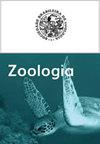Selective consumption of rodents by the Variable hawk Geranoaetus polyosoma (Accipitriformes: Accipitridae) in the Atacama Desert, northern Chile
IF 1.8
4区 生物学
Q4 ZOOLOGY
引用次数: 0
Abstract
Geranoaetus polyosoma (Quoy & Gaimard, 1824) is a diurnal raptor widely distributed in South America. Although the trophic ecology of this bird has been more studied in the southern extreme of its range, little information is available on its dietary response to prey supply in desert environments. In the present study, we report on the trophic ecology of G. polyosoma in a sub-urban desert zone in northern Chile, with the following objectives: (1) to quantitatively describe its diet and (2) to determine its dietary selectivity in response to prey supply in the study area. The diet of G. polyosoma consisted mainly of rodents (97.2%). A greater preference (p 19.5 g): two native rodent species, Phyllotis xanthopygus (Waterhouse, 1837) and Eligmodontia puerulus (Philippi, 1896); and two introduced rodent species: Rattus rattus (Linnaeus, 1769) and R. norvegicus (Berkenhout, 1769).智利北部阿塔卡马沙漠中变鹰对啮齿动物的选择性消耗(棘目:棘目科)
Geranoaetus polyosoma (Quoy & Gaimard, 1824)是一种广泛分布于南美洲的昼行猛禽。虽然这种鸟的营养生态学已经在其活动范围的最南端得到了更多的研究,但在沙漠环境中,它对猎物供应的饮食反应的信息很少。在本研究中,我们报告了智利北部近郊沙漠地带的G. polyosoma的营养生态学,目的如下:(1)定量描述其饮食;(2)确定其饮食选择对研究区域猎物供应的响应。多瘤田鼠以啮齿动物为主(97.2%)。更大的偏好(p 19.5 g):两种本地啮齿动物,Phyllotis xanthopygus (Waterhouse, 1837)和Eligmodontia puerulus (Philippi, 1896);两种引进鼠种:Rattus Rattus (Linnaeus, 1769)和褐家鼠(Berkenhout, 1769)。
本文章由计算机程序翻译,如有差异,请以英文原文为准。
求助全文
约1分钟内获得全文
求助全文
来源期刊

Zoologia
生物-动物学
自引率
0.00%
发文量
15
期刊介绍:
Zoologia, the scientific journal of the Sociedade Brasileira de Zoologia (SBZ), is an international peer-reviewed, open-access Zoological journal that publishes original research on systematics, evolution, taxonomy, nomenclature, biogeography, morphology, physiology, biology, ecology, symbiosis, conservation, behavior, genetics and allied fields. The journal, formerly known as Revista Brasileira de Zoologia, publishes original articles authored by both members and non-members of the Society. The manuscripts should be written exclusively in English.
 求助内容:
求助内容: 应助结果提醒方式:
应助结果提醒方式:


